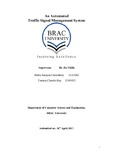| dc.contributor.advisor | Uddin, Jia | |
| dc.contributor.author | Chowdhury, Partha Narayan | |
| dc.contributor.author | Ray, Tonmoy Chandra | |
| dc.date.accessioned | 2017-06-19T07:16:58Z | |
| dc.date.available | 2017-06-19T07:16:58Z | |
| dc.date.copyright | 2017 | |
| dc.date.issued | 4/18/2017 | |
| dc.identifier.other | ID 13301062 | |
| dc.identifier.other | ID 13301023 | |
| dc.identifier.uri | http://hdl.handle.net/10361/8248 | |
| dc.description | Cataloged from PDF version of thesis report. | |
| dc.description | Includes bibliographical references (page XXIX - XXX). | |
| dc.description | This thesis report is submitted in partial fulfillment of the requirements for the degree of Bachelor of Science in Computer Science and Engineering, 2017. | en_US |
| dc.description.abstract | Today, traffic congestion has turned out to be a very significant issue due to the increasing number of vehicles and poor traffic management in our busy overcrowded cities. In order to maintain the continuous piling of vehicles at junctions, an efficient and productive approach is required which saves manual human effort, precious time and fuel. In this paper, we propose a model for the detection of vehicles at junctions in real time using image processing which results into an efficient traffic management process. This model uses the value parameter which indicates the image’s brightness level, from the HSV format of the image to distinguish between day and night time images. The day and night images are processed using two different methodologies in order to extract the number of vehicles present at each junction. In order to increase the computational speed of our system, we eliminated the traditional edge detection approach and implemented a foreground and background image comparison in order to obtain the number of existing vehicles during the day. Images during the night are processed for extracting the number of headlights present at junctions. Moreover, the circularity of extracted headlights is analyzed for differentiating between the headlights and its reflection on roads. The redundant count of vehicles due to illuminated fog lights is also handled using the image coordinate system. The experimental results of this proposed model show an average accuracy of 94.59% for vehicle detection during both day and night time using our dataset. The results from the image processing of both day and night time images are used as inputs in a signal time optimization algorithm which gives an efficient signal time for vehicles waiting at each road end. | en_US |
| dc.description.statementofresponsibility | Partha Narayan Chowdhury | |
| dc.description.statementofresponsibility | Tonmoy Chandra Ray | |
| dc.format.extent | 30 pages | |
| dc.language.iso | en | en_US |
| dc.publisher | BRAC University | en_US |
| dc.rights | BRAC University thesis are protected by copyright. They may be viewed from this source for any purpose, but reproduction or distribution in any format is prohibited without written permission. | |
| dc.subject | Signal management | en_US |
| dc.subject | Traffic signal | en_US |
| dc.title | An automated traffic signal management system | en_US |
| dc.type | Thesis | en_US |
| dc.contributor.department | Department of Computer Science and Engineering, BRAC University | |
| dc.description.degree | B. Computer Science and Engineering | |

